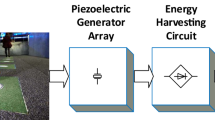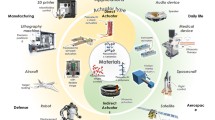Abstract
In this study, energy harvesting devices using Wiegand-effect transducer is investigated through integration with linear positioning measurement system. With the device, energy can be harvested due to the changes of magnetic polarities from linear position measurement system. Using numerical finite element method, the energy harvesting module is parametrically investigated to offer the optimal design in the magnetic guide that directs the dynamic magnetic field into the Wiegand transducer. From experiments, the influence of parameters such as geometry, speed and gap size has been validated to offer optimal design composition to provide the highest energy output from the system.















Similar content being viewed by others
References
Abe S, Matsushita A (1995) Induced pulse voltage in twisted vicalloy wire with compound magnetic effect. IEEE Trans Magn 31–6:3152–3154
Abe S, Matsushita A, Naoe M (1997) Annealing and torsion stress effect on magnetic anisotropy and magnetostriction of vicalloy fine wire. IEEE Trans Magn 33:3916–3918
Saggomo S, Ongaro F, Corradini L, Affanni A (2015) Low-power energy harvesting solutions for wiegand transducers. IEEE J Emerg Sel Top Power Electron 3–3:766–779
Sun X, Yamada T, Takemura Y (2019) Output characteristics and circuit modeling of wiegand sensor. Sensors 19–31:2991
Takahashi K, Takebuchi A, Yamada T, Takemura Y (2018) Power supply for medical implants by wiegand pulse generated from a magnetic wire. J Magn Soc Jpn 42:49–54
Takemura Y, Fujinaga N, Takebuchi A, Yamada T (2017) Batteryless hall sensor operated by energy harvesting from a single wiegand pulse. IEEE Trans Magn 53–11:4002706
Vazquez M, Gomez-Polo C, Chen D-X, Hernando A (1994) Magnetic bistability of amorphous wires and sensor applictions. IEEE Trans Magn 30:907–912
Wiegand J.R and Velinsky M. (1974) Bistable magnetic device. United States Patent #3,820,090.
Wiegand J.R. (1981) Switchable magnetic device. United States Patent #4,247,601.
Wigen PE (1975) Wiegand wire: new material for magnetic based devices. Electronics 48:100–105
Acknowledgements
The authors greatly appreciate the support from Ministry of Science and Technology of Taiwan through grant MOST 105–2622-E-007–008-CC2 for the work discussed herein.
Author information
Authors and Affiliations
Corresponding author
Additional information
Publisher's Note
Springer Nature remains neutral with regard to jurisdictional claims in published maps and institutional affiliations.
Rights and permissions
About this article
Cite this article
Chang, CC., Chang, JY. Novel Wiegand-effect based energy harvesting device for linear magnetic positioning system. Microsyst Technol 26, 3421–3426 (2020). https://doi.org/10.1007/s00542-020-04899-2
Received:
Accepted:
Published:
Issue Date:
DOI: https://doi.org/10.1007/s00542-020-04899-2




